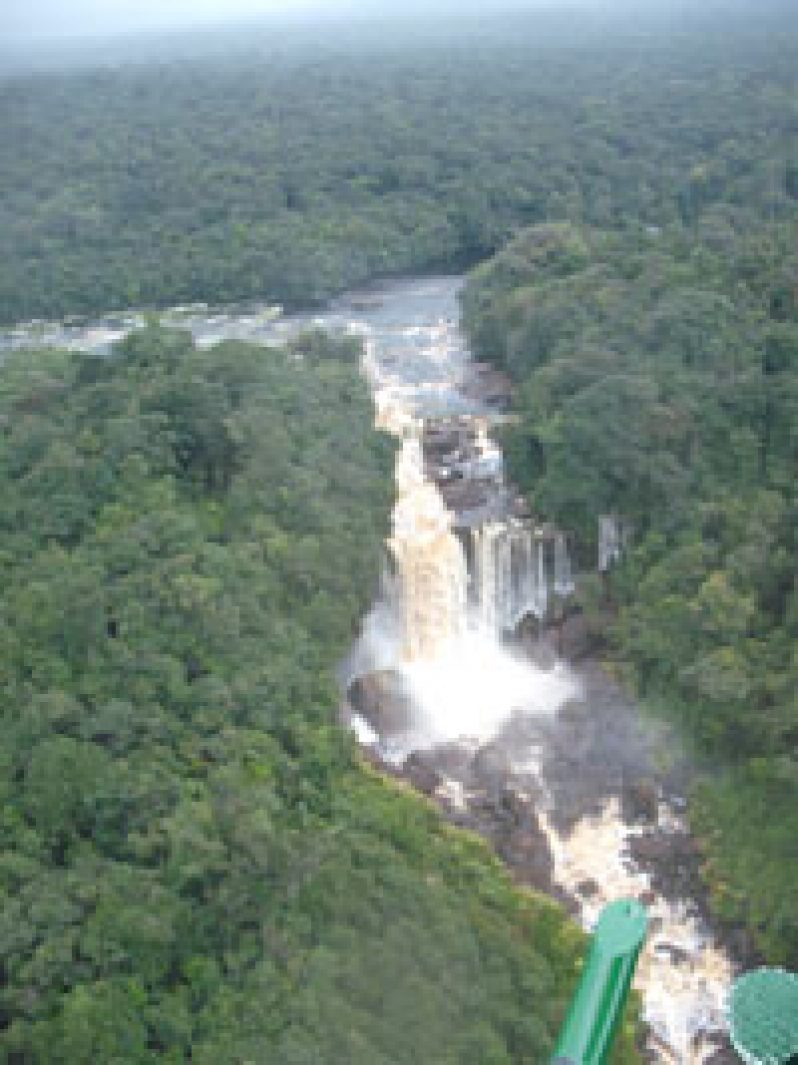GUYANA’s Amaila Falls Hydropower Project is “too important and too big to fail” and, despite the widespread condemnation of the political blackmail by the parliamentary Opposition parties (APNU and AFC), government says it is keeping its doors open to the Opposition to allow for a national consensus on the project.
 In fact, Public Works Minister Robeson Benn said yesterday that government is still hopeful that the Opposition would “see the light” and have their concerns, misunderstandings, and confusions sorted out.
In fact, Public Works Minister Robeson Benn said yesterday that government is still hopeful that the Opposition would “see the light” and have their concerns, misunderstandings, and confusions sorted out.
“And we would like to help them clear it up,” he told reporters while conducting a media tour to Amaila Falls, along with his Technical Advisor Walter Willis. Willis is also the Project Manager.
The tour was specifically designed to bring to the public’s attention how necessary it is for the authorities to proceed with the project. “We want to remind again at the last minute, at the 11th hour so to speak, Guyanese and those overseas as to the importance of the project, as to why it should be developed.”
FULL UNDERSTANDING
The intention is for everyone to have a full understanding of the project so that they will have no problem supporting it. In fact, no one should say at the end of the day that they did not have a thorough understanding of this “vital national project,” the minister asserted.
Reporters travelled to the site via two Guyana Defence Force (GDF) helicopters and were able to get a first-hand look at different sections of the project. The team flew over Sections 2, 3, 4, 5 and 7.
Landing briefly at Section Six, Minister Benn told media operatives that should this project collapse, people’s livelihoods would be affected and what is more, there will be a failure to bring in cheap hydro-electric power to the country.
“We have spent billions of dollars developing the road. It is fairly well built; many of the sections are completed. For the first time in the history of the country is the opportunity to have a complete, large hydropower project, meaning anything over 60 megawatts. In this case, for Amaila it is 160 megawatts,” Benn explained.
“We would think, given the importance of this project to the economic development of the country, that it is too important and too big to fail. We would want to still open the door to the Opposition parties (APNU and AFC) to allow for the opportunity to have a national consensus on this project. And so we are still holding the door open,” he assured.
NATIONAL PROJECT
The minister also stressed that Amaila is not simply a government project or a PPP/C project. “It is also an APNU project and an AFC project because it is a national project. But the government is seeking ways legally to examine what avenues are open to advance the project.”
Meanwhile, Willis told reporters that the Amaila Falls road is about 67 percent complete and work will continue until December 31, 2013 because the road project is expected to be done by that time.
Gerald Alvin McIntyre, who is responsible for Sections three and four, said because they know how essential Amaila is for Guyana, he and his team went as far as pledging that they will work up to 11:00 pm so as to have the works completed.
“Personally I feel betrayed. I didn’t think the Opposition would go so far. It is a project long overdue. Forget politics. It is a national project; that’s why I am here. The whole of Guyana should throw its weight behind this project,” he offered.
Floyd Trim, working in Sections five and six, said the project meant a lot to him. “Since I heard of it, I thought it was a good venture by the government. I don’t feel it should close down with the kind of effort that has gone into it already,” he said.
LCDS COMPONENT
The Amaila Hydropower Project is expected to generate reliable, affordable and clean energy and the project is a fundamental component of Guyana’s Low Carbon Development Strategy.
It is intended to significantly lower Guyana’s carbon footprint while reducing the country’s long term energy costs and exposure to the volatility of imported oil prices.
The project involves the construction of a hydropower plant in the area of west-central Guyana, where the Amaila and Kuribrong Rivers meet. Electricity produced at the plant will be delivered to the Guyana capital, Georgetown, and its second largest town, Linden, by an electric transmission line.
[Click on Image to Enlarge]



.jpg)









